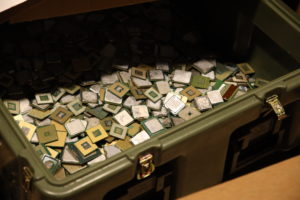In September 2022, the Securities and Exchange Commission announced charges against Morgan Stanley stemming from the company’s failures, over a five-year period, to protect the personal identifying information of approximately 15 million customers.
“The real crux of the problem was a misunderstanding between the information technology asset disposition (ITAD) company and Morgan Stanley,” says Matthew Young, founder of Baltimore, Md.-based electronics recycler Electronics Value Recovery (EVR). “The ITAD company received the hard drives through an intermediary, and thought the hard drives they received had been wiped when they really weren’t. There was a real fumble in the information hand-off.”
The situation presents a cautionary tale for consumers and businesses alike. Whether you’re running a small operation or multiple facilities, the data on electronics devices should be handled securely from a brand-new laptop to an end-of-life hard drive.
ISRI News met with Young to talk about EVR’s approach to handling data, how the company is working to recycle more electronics more efficiently, and the role of recycling in sustainability.
Q: Why is cybersecurity an important issue for all recyclers and electronics recyclers in particular?
Young: We all run businesses that need to be up and running all day. Cyber threats like ransomware or hacked technology can come into your network and completely shut down your system. You need to be up and running all day. If that happened to my business, we’d only be able to operate at about 10% productivity without our software systems up and running. With so much online, we’d be very limited. So, cybersecurity should be an important component for any recycling facility large or small.
 For electronics recyclers, cybersecurity is important to understand and recognize what can happen to customers if the job isn’t handled correctly. With Morgan Stanley, devices wound up in the hands of companies that didn’t realize there were millions of pieces of personally identifiable information on the drives.
For electronics recyclers, cybersecurity is important to understand and recognize what can happen to customers if the job isn’t handled correctly. With Morgan Stanley, devices wound up in the hands of companies that didn’t realize there were millions of pieces of personally identifiable information on the drives.
The situation highlights a real risk for your suppliers. It’s important to do your due diligence to make sure process controls are in place not only while the materials are in your facility but also what happens to them after they leave.
Q: Can you tell me about how EVR works to recycle end-of-life electronics efficiently?
Young: It begins with a contract that clearly lays out what the customer wants done with the material. For example, the contract would note whether the materials should be resold or processed for commodity recovery. There’s a variety of players in the chain of custody and different reporting that needs to be done when the materials are received and accepted. Once the material comes in, we determine whether it will get physically destroyed or if it will go through a data erasure process.
 We have checks and balances built in to ensure that what was documented as being received has gone through the entire process. Our data erasure process is even validated by a third-party forensic and recovery specialist. They confirm there is no information on the drives after our process is completed. There’s a high degree of technical sophistication that goes into the backend processes to make sure everything is correct.
We have checks and balances built in to ensure that what was documented as being received has gone through the entire process. Our data erasure process is even validated by a third-party forensic and recovery specialist. They confirm there is no information on the drives after our process is completed. There’s a high degree of technical sophistication that goes into the backend processes to make sure everything is correct.
Q: What happens to the hard drives that get wiped? Are they all able to get resold?
Young: The most important issue with wiped hard drives is quality. Just because a hard drive is the right size for someone to potentially buy it, it’s the quality factors that really determine if you can resell it. You need to review the health of the hard drive and the reallocated sector counts, and other details of the drive that determine if it could be resold. And that’s on top of the data erasure component. Hard drives have one of the most stringent sets of quality control parameters of all refurbished products in the industry.
You need to understand the market value of the drive you’re planning to wipe. Wiping a hard drive is more expensive than shredding it. If you can’t make money by wiping the hard drive, then it doesn’t make economic sense to do so. When you do data destruction you need also do a data validation to ensure the data is destroyed, then you need to package the inventory and store the hard drive before selling it, all of which make wiping more expensive.
Q: What are some issues on the horizon for electronics recyclers?
Young: When I started in the industry everyone was concerned about how to recycle cathode-ray-tubes (CRTs). Then concerns turned to mercury-containing devices, LCDs, and the Internet of Things (IoT). Now people are focusing on lithium-ion batteries. There’s been a lot of investment in the processing side for lithium and cobalt recovery. While those are valuable materials, it’s also very early to be making such large investments. The market could change again, as we’ve seen it adjust in the past. The electronics stream is constantly evolving, so it’s hard to predict what’s on the horizon.
Q: How does electronics recycling contribute to sustainability?
Young: Sustainability is great from an electronics recycling perspective because the best thing that can be done from a lifecycle perspective is reuse.
Photos Courtesy of ISRI.










